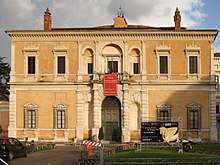National Etruscan Museum
The National Etruscan Museum (Italian: Museo Nazionale Etrusco) is a museum of the Etruscan civilization, housed in the Villa Giulia in Rome, Italy.
Museo Nazionale Etrusco | |
 Facade of the Villa Giulia in Rome, home of the National Etruscan Museum. | |
 Location of the museum in Rome | |
| Established | 1889 |
|---|---|
| Location | piazzale di Villa Giulia, 9 Rome, Italy |
| Type | National museum |

History
The villa was built for Pope Julius III, for whom it was named. It remained in papal property until 1870, when, in the wake of the Risorgimento and the demise of the Papal States, it became the property of the Kingdom of Italy. The museum was founded in 1889 as part of the same nationalistic movement, with the aim of collecting together all the pre-Roman antiquities of Latium, southern Etruria and Umbria belonging to the Etruscan and Faliscan civilizations, and has been housed in the villa since the beginning of the 20th century.
Collections
The museum's most famous single treasure is the terracotta funerary monument, the almost life-size Bride and Groom (the so-called Sarcofago degli Sposi, or Sarcophagus of the Spouses), reclining as if they were at a dinner party.
Other objects held are:
- The Etruscan-Phoenician Pyrgi Tablets[1]
- The Apollo of Veii[2]
- The Cista Ficoroni
- A reconstructed frieze displaying Tydeus eating the brain of his enemy Melanippus
- The Tita Vendia vase
- The Sarpedon krater (or, the "Euphronios krater") - this is now at the Archaeological Museum of Cerveteri, it was at the Villa Giulia from 2008-2014
- The Centaur of Vulci
See also
References
- Moretti, Anna Maria Sgubini, ed. (2001). The Villa Giulia National Etruscan Museum: Short Guide. Roma: "L'Erma" di Bretschneider; Ingegneria per la cultura. ISBN 88-8265-012-X.
External links
| Wikimedia Commons has media related to Museo Nazionale di Villa Giulia. |
- Museo Nazionale Etrusco information (in Italian)
